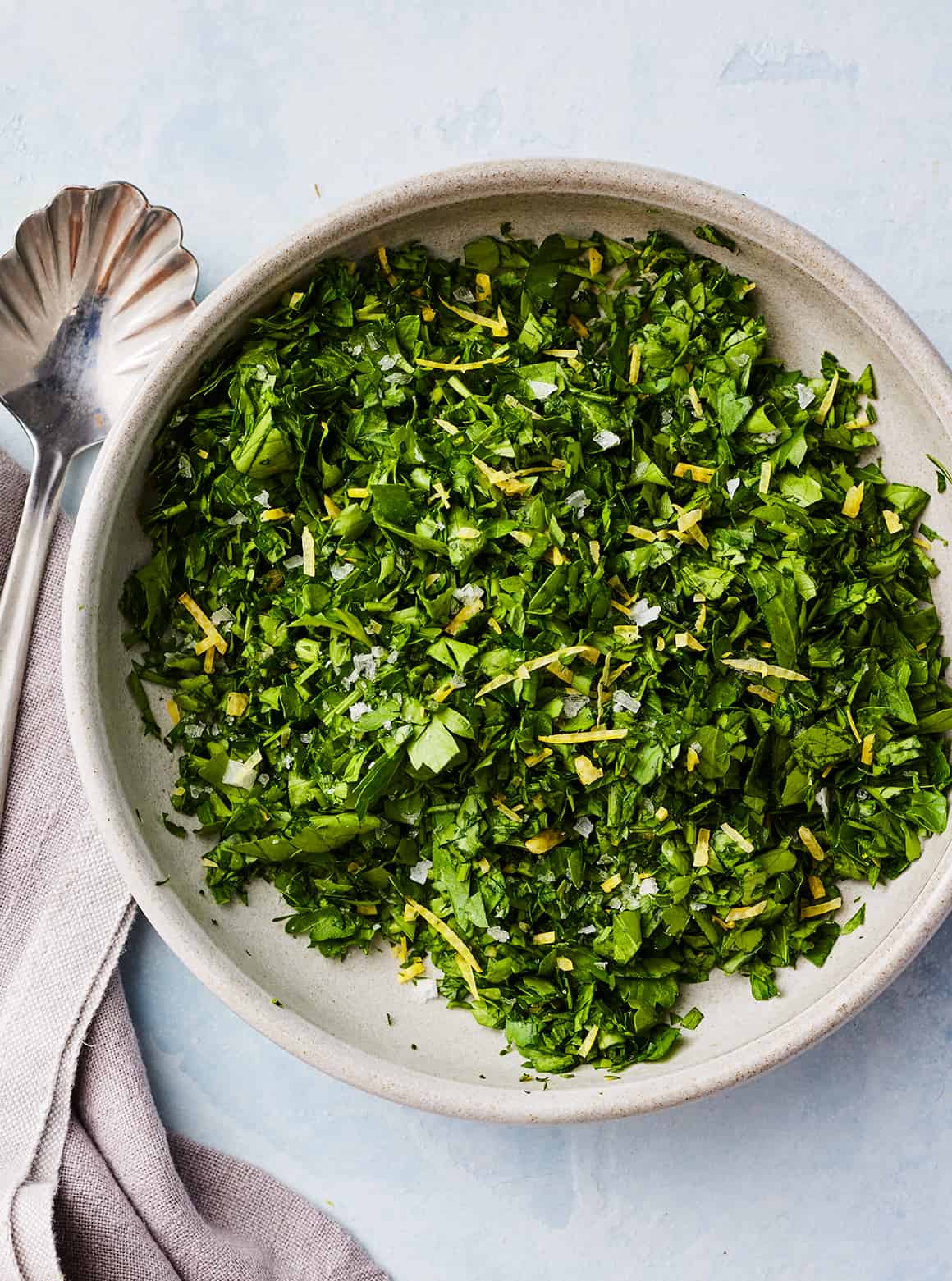
Gremolata is an Italian condiment made of parsley, garlic, and lemon zest. Sprinkle it over pasta, veggies, and more for a burst of fresh, bright flavor!

A sprinkle of parsley is one of my favorite ways to finish a dish, adding freshness and an appealing fleck of green. But if I really want to kick that same dish up a notch, I’ll sprinkle it with gremolata instead.
What Is Gremolata?
Gremolata might sound fancy, but really, it’s incredibly simple. An Italian condiment, it consists of chopped parsley mixed with lemon zest and garlic. The combination is zippy, bright, and fresh, making gremolata an easy way to liven up almost any dish.

How to Make Gremolata
Making gremolata is as simple as it sounds: all you have to do is mix together chopped parsley, garlic, and lemon zest. I also add a little salt to my recipe to pep up the gremolata’s flavor.

Be sure to use flat-leaf, or Italian, parsley in this gremolata recipe. It has a more robust flavor than curly parsley, and its softer texture makes it better suited for use here as well.

Rather than use a food processor to make gremolata, I like to chop the parsley by hand. I find that I have more control over the gremolata’s consistency this way. In a food processor, it’s easy to over-process the parsley, giving it a mushy texture.
And though I show finely chopping the lemon zest with a chef’s knife here, I generally grate it on my microplane zester. I also grate the garlic. That way, the fine shreds evenly incorporate with the parsley and you don’t end up with a big chunk of garlic in any one bite.

How to Use Gremolata
In Italian cuisine, gremolata is often served over lamb or osso buco, braised veal shanks. But obviously, the ways to use it don’t end there! Start experimenting with it in your kitchen, and you’ll find that it goes well on almost anything. Here are a few ideas to get you started:
- Sprinkle it over grilled veggies. We love it on grilled mushrooms, eggplant, and summer veggie skewers.
- Or roasted veggies. Try it on cauliflower, asparagus, or Brussels sprouts.
- Toss it with salads. You’ll find it in this tomato salad recipe.
- Sprinkle it over pasta. Try it on plain butter noodles, or add it to my roasted vegetable pasta or pasta primavera recipe.
- Stir it into polenta with a pat of butter, or sub it in for the chimichurri in this mushroom polenta recipe.
- Dust it onto a dip. Gussy up homemade hummus, baba ganoush, or white bean dip with a drizzle of olive oil and a little gremolata.
- Or scatter it over a soup. I especially love it with these brothy cannellini beans, potato leek soup, and classic minestrone.
How do you like to use gremolata? Let me know in the comments!

Variations
This recipe is a fairly classic version of gremolata. While it’s the kind I make most often, I also like to play with it depending on what I’m serving or what ingredients I have on hand. I hope you have fun making it your own, too. Here are a few ways I like to change it up:
- Switch the herb. No parsley? No problem. Make a version of gremolata with another soft, leafy herb such as cilantro, basil, or mint.
- Change the zest. Try using orange or lime instead of lemon.
- Add another ingredient. Stir in chopped pine nuts to add crunch or finely grated Parmesan or finely minced capers for salty, savory flavor.
Let me know what variations you try!

More Herby Sauces and Spreads
Love fresh herbs? Same! Try one of these herbaceous spreads or sauces next:

Gremolata
Serves 4 to 6
An Italian condiment, gremolata is a delicious bright, fresh topping for all sorts of dishes. Try it on pasta, roasted veggies, and more!
- 1 bunch fresh parsley, finely chopped (about ¾ cup)
- 2 teaspoons lemon zest
- 1 garlic clove, grated
- ⅛ teaspoon sea salt
-
In a small bowl, stir together the parsley, lemon zest, garlic, and salt.
-
See the blog post above for suggestions to use the gremolata.
Sources: The Art of Simple Food by Alice Waters